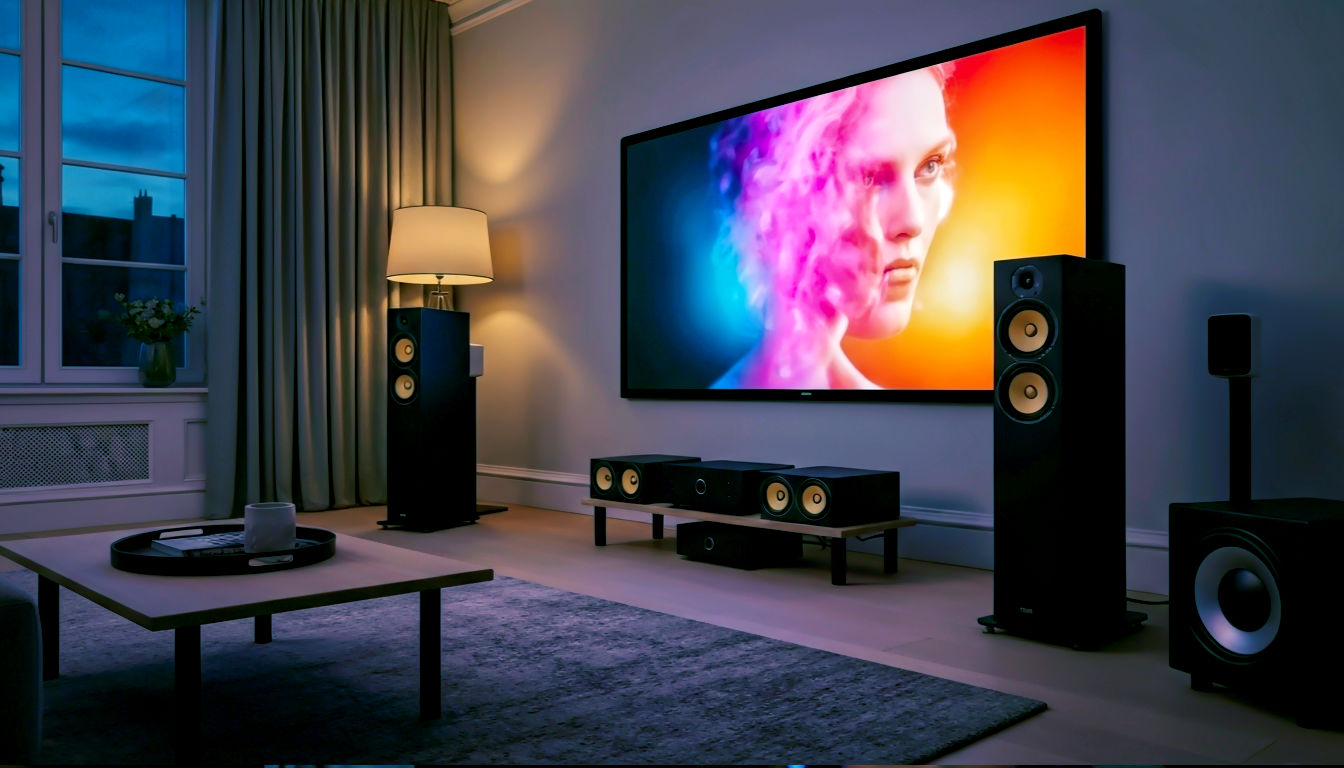Home Cinema Speakers: Your Ultimate Setup Guide
The definitive guide for Brits on home cinema speakers. We cut through the jargon to help you build the perfect surround sound system for your living room.

This post may contain affiliate links. If you make a purchase through these links, we may earn a commission at no additional cost to you.
You’re settled on the sofa, the snacks are ready, and the lights are dimmed. You press play on the latest blockbuster. On screen, a spaceship roars past. But on your TV, it sounds less like a thunderous engine and more like a disgruntled hairdryer. The actor whispers a crucial line of dialogue, but it’s lost in a muddle of background noise.
Sound familiar? For too long, we’ve put up with the tinny, lifeless sound that comes from the tiny speakers built into our super-slim televisions. But here’s the secret: the heart of a truly cinematic experience isn’t just about the picture. It’s about the sound.
Getting that room-shaking, heart-pounding, immersive audio you feel in a proper cinema isn’t some dark art reserved for millionaires and tech wizards. It’s something you can achieve in your own living room. This guide is your map. We’ll cut through the jargon, demystify the numbers, and walk you through everything you need to know to build a home cinema sound system that will transform your movie nights forever. Forget the hairdryer; it’s time to unleash the thunder.
What on Earth is Surround Sound? The Basics Explained
Before we start picking out speakers, let’s get our heads around the big idea: surround sound.
Think about how you hear the world every day. If a car drives past you on the left, you hear it on your left. If someone calls your name from behind, you turn around. Our brains use two ears to create a 3D “sound map” of our surroundings. Surround sound tries to recreate that in your living room.
Instead of all the sound coming from one place (your TV), it uses multiple speakers placed around you to put you right in the middle of the action. It’s the difference between watching a film and being in it.
To do this, sound engineers create a movie soundtrack with different sounds assigned to different “channels.” Each channel then goes to a specific speaker. It’s like an orchestra – the violins are in one spot, the drums in another. Each speaker has a part to play in building the complete picture.
Channels: Counting the Speakers
You’ll see lots of numbers thrown around, like 5.1 or 7.1.2. It sounds complicated, but it’s really just a simple way of counting the speakers.
- The first number tells you how many main speakers there are (the ones handling dialogue, music, and effects).
- The second number (the “.1”) tells you if there’s a subwoofer – a special speaker just for deep bass rumbles.
- A third number (like in 5.1.2) is a newer addition for formats like Dolby Atmos, and it tells you how many speakers are firing sound from above.
Let’s break down the common setups.
Stereo (2.0 and 2.1): The Starting Point
This is the classic hi-fi setup. You have two speakers, one on the left and one on the right of your TV. This is called a 2.0 system. It’s great for music and a huge step up from your TV’s built-in speakers, creating a wide “soundstage.”
Add a subwoofer for that deep bass, and you have a 2.1 system. This is a brilliant, simple upgrade that adds weight and excitement to everything you watch.
The Classic 5.1 Setup: The Gold Standard
For decades, 5.1 has been the standard for true surround sound. It’s what you get on most DVDs, Blu-rays, and streaming services. It’s the perfect balance of immersion and practicality for most British living rooms.
A 5.1 system has:
- Three speakers at the front: A centre, a front left, and a front right.
- Two speakers at the back/sides: A surround left and a surround right.
- One subwoofer.
This setup lets sound move around you. When a car drives from left to right across the screen, the sound will move smoothly from your front left speaker to your front right. When a plane flies overhead and behind you, the sound will travel from the front speakers to the surround speakers. It’s a game-changer.
Going Further with 7.1: More Immersion
A 7.1 system takes everything a 5.1 setup does and adds two extra speakers. These are called “rear surrounds,” and they sit behind you.
This creates an even more seamless and convincing 360-degree bubble of sound. The difference can be subtle, but for larger rooms or for people who want the absolute best, it fills in the gap at the very back of the room, making effects like fly-overs or crowds even more realistic.
Reaching for the Sky: Dolby Atmos and DTS:X
This is the biggest leap in home cinema sound since 5.1. Formats like Dolby Atmos and DTS:X add a height dimension. Suddenly, sound isn’t just around you; it’s also above you.
Instead of counting channels with a third number (e.g., 5.1.2 or 7.1.4), these systems use “sound objects.” The sound of a helicopter isn’t just sent to a speaker; it’s treated as an object that the system can place and move anywhere in your room – including directly overhead.
This is achieved with extra speakers. A 5.1.2 system is a standard 5.1 setup with two extra height speakers. A 7.1.4 system is a 7.1 setup with four height speakers. The result is a truly three-dimensional dome of sound. Rain sounds like it’s actually falling on your roof. You’ll find yourself ducking as things fly over your head. It’s astonishingly effective.
Meet the Team: A Guide to Each Speaker in Your Setup
A surround sound system is a team effort. Each speaker has a specific job, and they all need to work together. Let’s meet the players.
The Centre Channel: The Most Important Speaker?
Many experts will tell you the centre speaker is the most important one in your entire system, and they’re right. Why? Because it handles almost all of the dialogue.
Think about it. In any film, the dialogue is the anchor. If you can’t hear what the actors are saying, the story is lost. The centre speaker is designed specifically to make voices clear and anchor them to the screen. When someone is talking on-screen, the sound comes directly from their location, not from the sides. It’s a crucial job. Never skimp on your centre speaker.
The Front Left and Right Speakers: The Action Heroes
These are the workhorses of your system. In a 5.1 setup, the front left and right speakers do a lot of the heavy lifting. They handle the musical score, the main sound effects, and create the sense of space and width at the front of the room. When a car screeches around a corner, these speakers pan the sound across your screen. They are the foundation of your soundstage.
The Surround Speakers: Creating the Atmosphere
The surround speakers (sometimes called rears) are what make the magic happen. Their job is to create ambiance and envelop you in the environment of the film.
They handle things like the chatter of a crowd in a restaurant, the gentle pitter-patter of rain, or the subtle rustle of leaves in a forest. They also deliver the big, dramatic effects, like bullets whizzing past your ear or an explosion happening behind you. They are the reason you’ll jump out of your seat and look over your shoulder.
The Subwoofer: Bringing the Rumble
Your other speakers handle the highs and the mids, but the subwoofer is the bass specialist. It has one job: to reproduce the very lowest frequencies, the ones you often feel as much as you hear.
This is called the Low-Frequency Effects (LFE) channel. It’s the deep, gut-punching rumble of an explosion, the thumping footsteps of a T-Rex, or the thrum of a spaceship’s engine. A good subwoofer adds weight, scale, and excitement to a movie soundtrack. Without one, your system will sound thin and unconvincing.
The Height Speakers: The Sound from Above
For Dolby Atmos and DTS:X, you need height speakers. These can be speakers installed directly in or on your ceiling for the best effect.
However, a clever alternative is up-firing speakers. These can be separate modules that sit on top of your existing front or rear speakers, or they can be built into the speakers themselves. They work by bouncing sound off your ceiling and down to your listening position. It’s a surprisingly effective trick that saves you from drilling holes in the ceiling, making it perfect for most homes.
Choosing Your Weapons: Floorstanders, Bookshelf, or Hidden Speakers?
Once you know what speakers you need, you have to decide what type of speaker to get. This often comes down to your room size, your budget, and how much you want your speakers to be seen.
Floorstanding Speakers: The Big Guns
As the name suggests, floorstanders (or tower speakers) are tall speakers that stand directly on the floor. They are often used for the front left and right channels.
- Pros: Their large size means they can produce a big, powerful sound with deep, authoritative bass. They don’t need separate stands, and they often make a real statement in a room.
- Cons: They take up a fair bit of floor space, which can be a problem in smaller British lounges. They are also typically the most expensive option.
Bookshelf Speakers: The Versatile Performers
Don’t let the name fool you. While you can put them on a sturdy bookshelf, these compact speakers perform best when placed on dedicated speaker stands. They are a fantastically versatile choice and can be used for any channel in your system – fronts, surrounds, or even heights.
- Pros: They offer incredible sound quality for their size and are often much more affordable than floorstanders. Their smaller footprint makes them ideal for most rooms. Top British brands like Q Acoustics and Monitor Audio make some truly brilliant bookshelf speakers.
- Cons: Because they’re smaller, they won’t produce the same deep bass as a floorstander. You’ll definitely need a good subwoofer to pair with them. You also need to factor in the cost and space for speaker stands.
Satellite Speakers: Small and Mighty
Satellite speakers are very small, compact speakers, often sold as part of an all-in-one “sub/sat” package.
- Pros: Their tiny size makes them incredibly easy to place and very discreet. They are a great solution when space is at a premium or you want a system that blends into the decor.
- Cons: Physics is physics. Their tiny cabinets mean they can’t produce much bass or mid-range sound at all. They rely heavily on the subwoofer to fill in the gaps, which can sometimes make the sound feel a bit disconnected.
In-Wall and In-Ceiling Speakers: The Invisible Option
For the ultimate minimalist look, you can install speakers directly into your walls or ceiling.
- Pros: They are completely invisible, offering a zero-clutter solution that keeps your decor clean. This is the go-to for dedicated cinema rooms.
- Cons: Installation is a much bigger job, often requiring professional help to cut into plasterboard and run wires. The sound quality can also be compromised compared to a traditional box speaker, as they rely on the wall cavity behind them. They are a permanent fixture, so not ideal for renters.
The Conductor of the Orchestra: The AV Receiver
If the speakers are the orchestra, the Audio/Video (AV) Receiver is the conductor. It’s the central hub that brings everything together. You plug all your sources into it (Sky box, PlayStation, Blu-ray player), and it does three crucial jobs:
- Decoding: It reads the digital sound format (like Dolby Atmos) from your movie and understands which sound needs to go to which speaker.
- Powering: It has built-in amplifiers that send power to each of your speakers, making them produce sound.
- Switching: It lets you switch between different picture and sound sources with the press of a button, sending the video to your TV or projector.
When choosing an AV receiver, look for:
- Number of Channels: Make sure it can power the number of speakers you want. A 7.2 receiver can power seven speakers and two subwoofers. A 9.2 receiver can handle a 5.1.4 Atmos setup.
- Power (Watts per Channel): Don’t get too obsessed with this number, but make sure it has enough power to drive your chosen speakers comfortably.
- Inputs/Outputs: You’ll need enough HDMI inputs for all your devices. If you have a new games console or TV, look for HDMI 2.1 support for features like 4K gaming at 120Hz.
- Sound Formats: Ensure it supports the latest formats, primarily Dolby Atmos and DTS:X.
The Language of Sound: Dolby vs. DTS
For years, Dolby and DTS have been the two big names in cinema sound, competing to create the most immersive formats. You don’t need to lose sleep over which is “better,” as most modern AV receivers and discs will support both.
The Old Guard: Dolby Digital and DTS
These are “lossy” formats, meaning some of the original audio data is compressed to save space on a disc. They are the bedrock of 5.1 surround sound and still sound fantastic. DTS often uses a slightly higher bitrate, which some people claim gives it an edge in quality, but in reality, both are excellent.
The New Wave: Dolby Atmos and DTS:X Explained
These are the new “object-based” audio formats we talked about earlier.
Imagine a traditional 5.1 mix is like a painting. The sound of a bird is painted into the top-left corner (the front-left speaker). It can’t move.
With Dolby Atmos, that bird is a 3D object. The sound engineer can say, “I want this bird to start behind the sofa, fly over the viewer’s head, and land on the telly.” Your AV receiver then calculates in real-time how to use your specific speaker setup (whether it’s 5.1.2 or 7.1.4) to make that happen. It creates a seamless, three-dimensional soundscape that is far more realistic. DTS:X is DTS’s version of the same technology, and it works in a very similar way.
The Perfect Placement: How to Set Up Your Room
You can have the best speakers in the world, but if you just plonk them down anywhere, they won’t sound right. Speaker placement is crucial, and it costs nothing but a bit of time.
The goal is to create a symmetrical layout with your main listening position (your favourite spot on the sofa) at the centre. The diagrams from Dolby are the industry standard and your best friend here.
The Ideal 5.1 Layout
- Centre Speaker: Place it directly above or, preferably, below your TV screen, angled slightly up or down towards your ears.
- Front Left & Right: Place them on either side of the TV, equidistant from it and from your listening position. They should form an equilateral triangle with you. “Toe-in” the speakers slightly, so they point directly at your head.
- Surround Left & Right: These should be placed to the sides and slightly behind your listening position, a foot or two above ear level.
Placing 7.1 Speakers
A 7.1 setup follows the same rules as 5.1 but adds two Rear Surround speakers. These go behind you, fairly close together, also above ear level.
Where to Put Your Atmos Speakers
- In-Ceiling: The ideal placement is slightly in front of and behind your listening position, in line with your main front speakers.
- Up-Firing: Simply place them on top of your front and/or rear speakers.
The Subwoofer Crawl: Finding the Best Spot for Bass
The subwoofer’s placement is less obvious and has a huge impact on performance. The bass response in a room is lumpy, with “peaks” (too boomy) and “nulls” (no bass at all). Don’t just stick it in a corner and hope for the best. Try the “subwoofer crawl.”
- Place the subwoofer in your main listening position (yes, on the sofa!).
- Put on a piece of music or a film scene with a constant, repeating bassline.
- Crawl around the floor on your hands and knees along the walls of your room.
- Listen for the spot where the bass sounds the most even, tight, and clear.
- That’s where your subwoofer should go! It sounds silly, but it really works.
Fine-Tuning Your System: Calibration for Perfect Sound
Once your speakers are in place, the final step is to calibrate the system. This means telling your AV receiver how far away each speaker is, how loud it is, and how it interacts with your room’s acoustics.
Automatic Calibration: Using the Mic
Nearly every modern AV receiver comes with a small microphone and an automatic setup system. Popular names include Audyssey, Dirac Live, and YPAO (from Yamaha).
You place the microphone at your main listening position (at ear height) and run the setup routine. The receiver sends test tones to each speaker, measures the response, and automatically adjusts the settings for:
- Distance/Delay: To make sure sound from all speakers reaches you at the exact same time.
- Level: To ensure every speaker is at the same volume from your seat.
- Equalisation (EQ): This is the clever part. It listens to how your room affects the sound (e.g., bare walls might make it sound harsh, thick carpets might dull it) and applies corrections to make it sound as clean and accurate as possible.
Manual Tweaks: Getting It Just Right
Automatic systems are great, but you can also check and tweak things manually. The most common adjustment is speaker levels. You can use a Sound Pressure Level (SPL) meter app on your smartphone and the receiver’s built-in test tones to make sure every speaker is playing at the same volume.
To Wire or Not to Wire? The Great Debate
Traditionally, home cinema meant running lots of speaker wire around your room.
The Reliability of Wires
Wired connections are still the gold standard for quality and reliability. They deliver uncompressed sound with zero delay and aren’t susceptible to Wi-Fi dropouts. For your main front speakers and centre channel, wired is absolutely the way to go. Don’t go crazy on expensive cables, but avoid the super-thin, bell-wire stuff. A decent quality 14- or 16-gauge oxygen-free copper (OFC) speaker cable is all you need.
The Convenience of Wireless
Running cables to surround speakers can be a pain. This is where wireless technology comes in. Some systems now offer wireless surround speakers or subwoofers. They still need to be plugged into the wall for power, but they connect to the main unit via their own wireless signal. This can be a brilliant, clutter-free solution, especially for surround channels where the signal isn’t as critical as the front three.
The Big Question: Soundbar or a Full Speaker Package?
With the rise of high-quality Dolby Atmos soundbars, many people wonder if they really need a full system of separate speakers. It’s a fair question.
The Case for the Soundbar
A modern soundbar is a marvel of engineering. A single bar can contain multiple drivers angled in different directions to simulate surround sound and even bounce sound off the ceiling for a virtual Atmos effect.
- Pros: Incredibly simple to set up, takes up minimal space, and is a massive upgrade over TV speakers. Perfect for smaller rooms, minimalist setups, and people who don’t want the clutter of multiple speakers and wires.
- Cons: It’s still a simulation. It can’t truly replicate the feeling of having speakers physically behind you. The stereo separation and soundstage at the front are also much narrower than with two separate speakers.
The Case for a Speaker Package
A proper system of separate speakers (often called an AV package) is the purist’s choice for the ultimate performance.
- Pros: Unbeatable immersion. Real speakers create a real sound field that you can’t simulate. You get a huge, wide soundstage and precise placement of effects. It’s also a flexible, modular system you can upgrade one piece at a time.
- Cons: It costs more, takes up much more space, and is more complex to set up.
The choice is yours. A good soundbar is better than a badly set up, cheap speaker package. But a well-planned package of separate speakers will always deliver a more authentic and thrilling cinema experience.
Common Mistakes Everyone Makes (And How to Avoid Them)
Building a great system is as much about avoiding common pitfalls as it is about buying the right gear.
- Mismatched Front Speakers: Try to use speakers from the same brand and range for your front three (centre, left, right). This ensures a consistent “timbre” or tonal character, so sounds pan smoothly across the screen without changing their sound.
- Poor Placement: Don’t hide your centre speaker in a deep cabinet or put your surround speakers in the wrong place. Follow the Dolby layout guides. It makes a world of difference.
- Ignoring Room Acoustics: A room with lots of hard surfaces (wooden floors, bare walls, big windows) will sound bright and echoey. A few simple additions like a thick rug, curtains, and some cushions can absorb reflections and dramatically improve the sound.
- Hiding the Subwoofer: Shoving your sub behind the sofa or deep in a cabinet will muffle its sound, making it boomy and indistinct. Give it some breathing room.
- Setting Surrounds Too Loud: The surround speakers are for atmosphere, not to be the main event. A common mistake is to turn them up too loud. They should blend in seamlessly, only making their presence known when a specific effect calls for it.
The Future is Heard, Not Seen
The world of home audio is always moving. We’re seeing more high-quality wireless systems that make setup even easier. Calibration technology like Dirac Live is getting smarter, using advanced AI to better understand and correct for your room’s specific acoustics. And as streaming services offer more and more content in Dolby Atmos, that truly three-dimensional sound experience will become the new standard.
Conclusion: Your Cinema Awaits
Building a home cinema sound system can seem daunting. There are numbers, acronyms, and endless choices. But as we’ve seen, it all boils down to a few simple principles: get the right number of speakers for your room, put them in the right places, and connect them to a receiver that can bring them to life.
Whether you start with a simple 2.1 system and build from there, or dive straight into a full Dolby Atmos setup, the effort is worth it. You’ll hear your favourite films in a whole new way. You’ll hear details you never noticed before. You’ll feel every explosion and jump at every creak. You won’t just be watching the movie anymore. You’ll be in it. And that’s a kind of magic you can have any night of the week.
Further Reading & Resources
For reviews, in-depth technical guides, and community discussions, these UK-based resources are invaluable:
- What Hi-Fi?: The UK’s leading publication for home entertainment reviews and news.
- AVForums: A massive and incredibly knowledgeable community of home cinema enthusiasts. Their forums are a treasure trove of information.
- Dolby’s Speaker Setup Guides: The definitive source for speaker placement diagrams for all common configurations.






